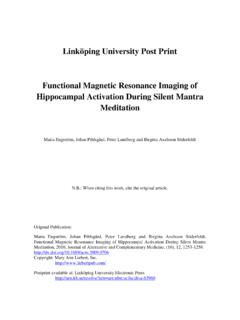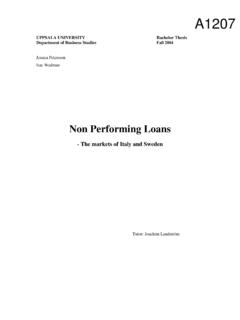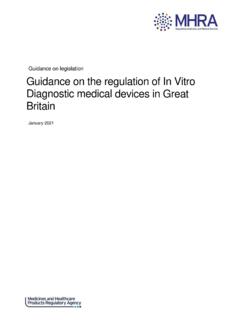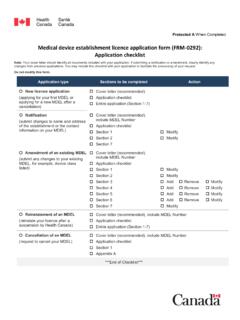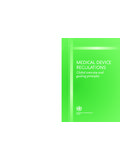Transcription of Global Regulatory Requirements for Medical Devices
1 M lardalen UniversityDepartment of Biology andChemical EngineeringGlobal Regulatory RequirementsforMedical DevicesSandra BrolinSupervisor at Synergus ABLianZhangExaminer at M larenUniversitySven Hamp2 AbstractMedical Devices are becoming more important in the health care sector. One ofthe major issues for companies developing and producing Medical Devices is to beupdated on the Regulatory Requirements and implement them in the process. Thisthesis examines the Regulatory Requirements for Medical Devices in Argentina,Australia, Brazil, Canada, India, Japan, Mexico, Russia, South Korea and Taiwanand compares them with the requirementsin the European conclusion of this thesis is that most countries have similar Requirements forregistrationof Medical Devices and are striving to harmonize with the company goesfar by following the Requirements in EU, USA or theGHTF of content1.
2 What is A Medical Device?.. Classification of Medical Quality Management Regulation of Medical General Product General Product General Product General Product General Product General Product General Product General Product South General Product General Product Devices are becoming more important in the health care sector. Todaythere aremore than 8000 generic Medical device groups where some devicescontaindrugs [1].
3 This increases the demand for better Regulatory frameworks toensure that products entering the market are safe and efficient. One of the majorissues for companies developing and producing Medical Devices is to be updatedon the Regulatory Requirements and implement them in the process. A companythat does not succeed with this may loose thousands of dollars in the delay ofmarketing the product[2]. is A Medical Device?A Medical device is according to the European definition any instrument,apparatus, appliance, material or other article, whether used alone or incombination, including the software necessary for its proper application intendedby the manufacturer to be used for human beings for the purpose of.
4 -Diagnosis, prevention, monitoring, treatment or alleviation of disease,-Diagnosis, monitoring, treatment, alleviation of or compensation for an injury orhandicap,-Investigation, replacement or modification of the anatomy or of a physiologicalprocess,-Control of conception,and which does not achieve its principal intended action in or on the human bodyby pharmacological, immunological or metabolic means, but which may beassisted in its function by such means [3].This means that Medical Devices are everything from band aidsto x-ray machines,contact lenses, hip implants, pacemakers, crutches, hospital beds and in vitrodiagnostic Devices are usually divided into subgroups.
5 In Europe Medical devicesare divided into three different groups; active implantable Medical Devices (AIMD), general Medical Devices and in vitro diagnostic Devices (IVD). Thesegroups are recognized and used by other countries as well. The main differencebetween countries is how these Devices are regulated. In some countries medicaldevices are regulated as drugs and in other countries there are special regulationsfor Medical Devices . Medical Devices can in turn be regulated as one group orregulated separately, usually as one of the Europe general Medical Devices are divided into non invasive Devices , invasivedevices and active Devices .
6 An active Medical device is a device that requires asource of energy to function. An invasive Medical device is a product that in someway enters the human body. The device is then called invasive, surgically invasiveorimplantable depending on how the device is entering the body and the time it isintroduced to the body. An in vitro diagnostic device is a reagent, reagent product,instrument or system used to examine samples from human tissues or fluids togain information. In vitro diagnostic Devices are also divided into subgroups[2].
7 Of Medical DevicesMedical Devices are usually divided into different classes. Some countries haveseparate classification systems for general Medical Devices , active Medical devicesfor implantation and in vitro diagnostic Devices while other countries classifythese products after the same system. All classification systems are risk of Medical Devices is necessary to apply correct regulationsandquality the United States Medical Devices are classified as class I (General Controls), II(Special Controls) or III (Pre-market Approval) Devices where class III devicesrepresent the highest risk and require more control.
8 Medical Devices are classifiedthrough a classification database found at the FDA homepage and are given aseven digit number based on the product category[4].In the European Union general Medical Devices are classified as class I, class Isterile, class I measuring, class IIa, class IIb or class III where class III devicesrepresent the highest risk. Active implantable Medical Devices are not classifiedand in vitro diagnostic Devices have their own classification system. Informationon the European classification system is found inMEDDEV Theclassification rules are found in Annex IX of Directive 93/42/EEG[2].
9 The Global Harmonization Task Force described further down has developed arecommended classification system where Medical Devices are divided intoclassA, B, C and D where class D represents the highest risk. This system is however arecommendation to Regulatory authorities and not to companies. Information onthe GHTF recommended classification system is found in the GHTF documentPrinciples of Medical Devices nomenclature is usually given to a Medical device when it is classified. Thereare two international nomenclatures that are very common: The Emergency Care Research Institute (ECRI) nomenclature called theUniversal Medical Device Nomenclature System (UMDNS).
10 The UMDNS terms are harmonized with the classification system of the USAand exist inten languages[5]. The Global Medical Device Nomenclature (GMDN) GMND code is built according to EN ISO 15225 and is acollaborationbetween the EU, EFTA, USA and Canada[6].The GMDN terms only existin Englishbut can be translated withspecialsoftware. This nomenclaturesystem isrequired for registering a Medical devicewithin the EU [7].Both systemsconsist ofdefined terms that describe a group of products withsimilar GMDN system is developed from6 differentnomenclature systems and the UMDNS system is one of them.


